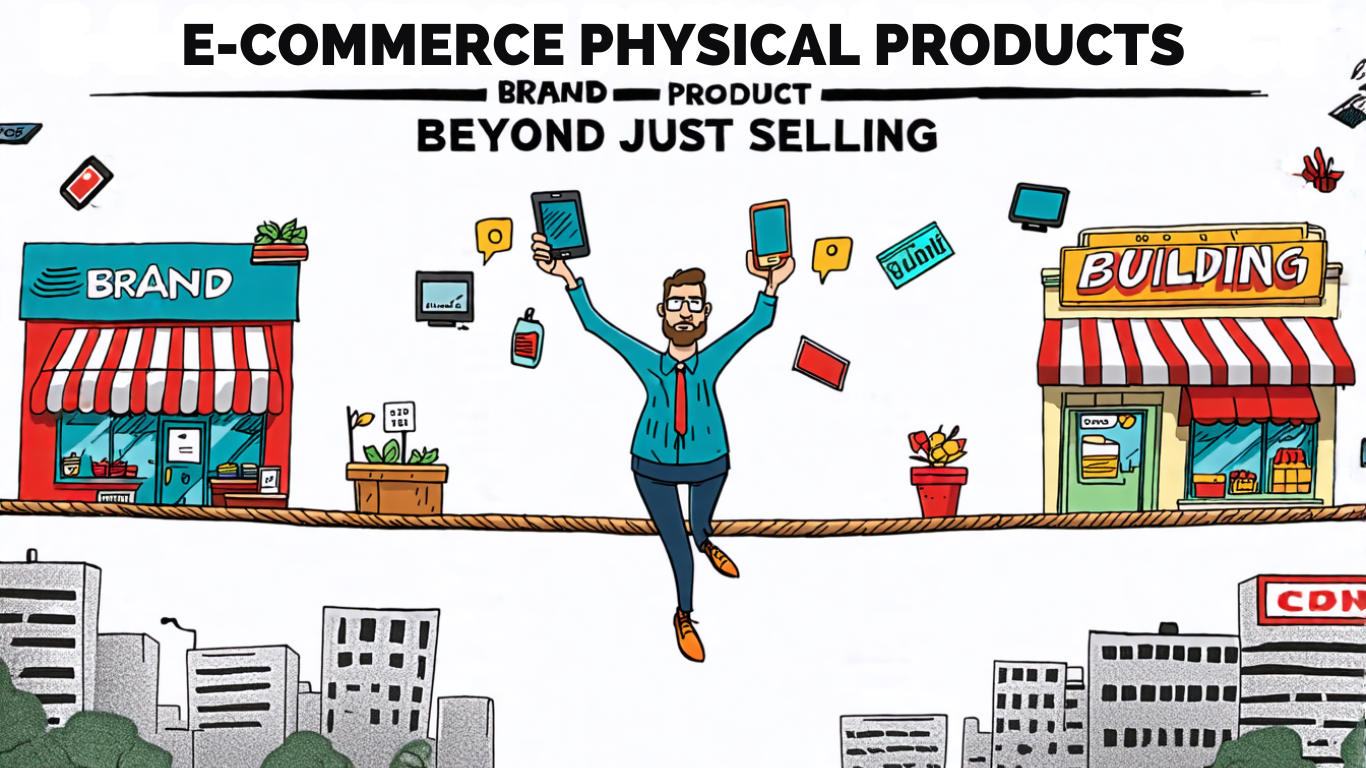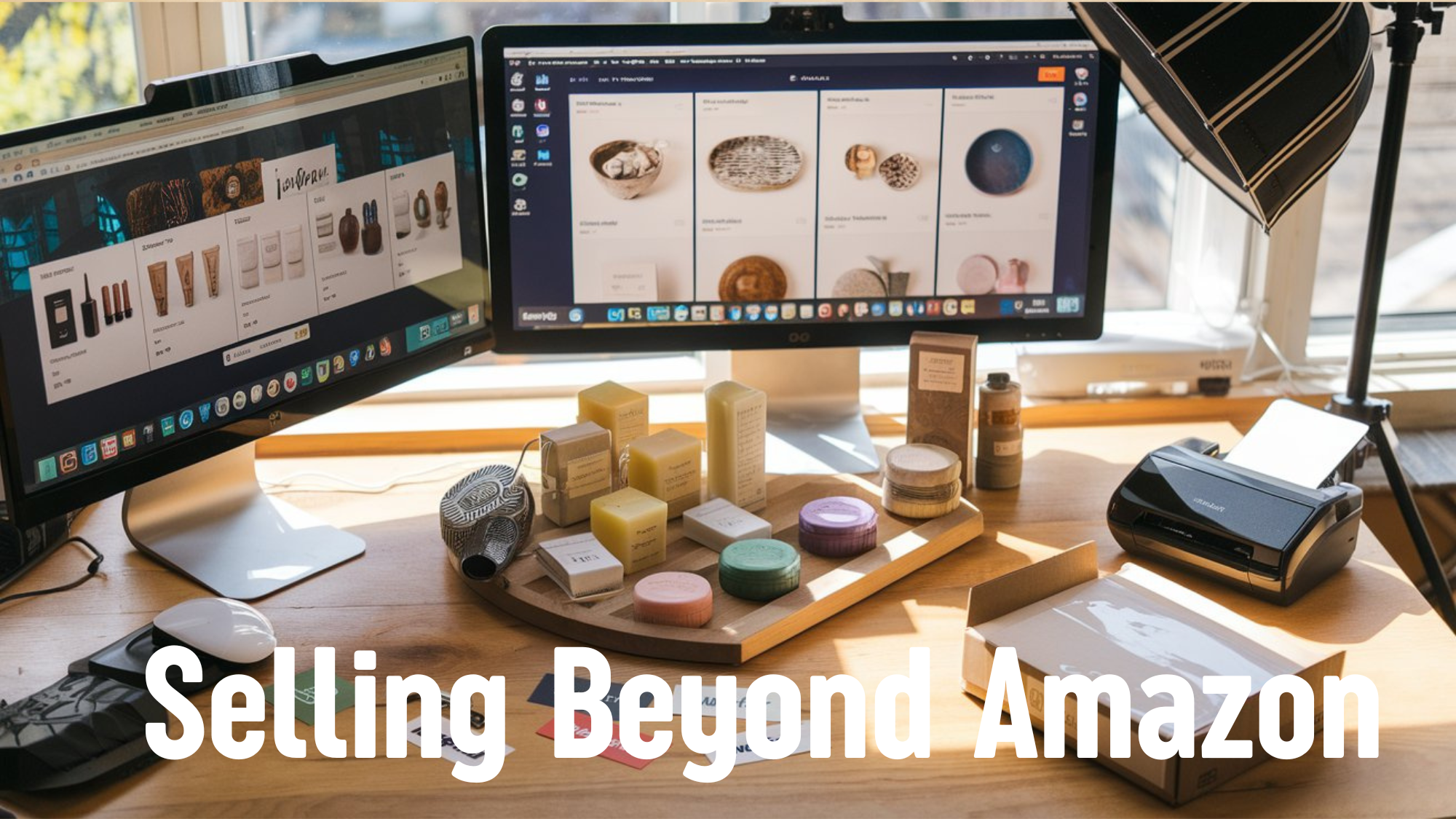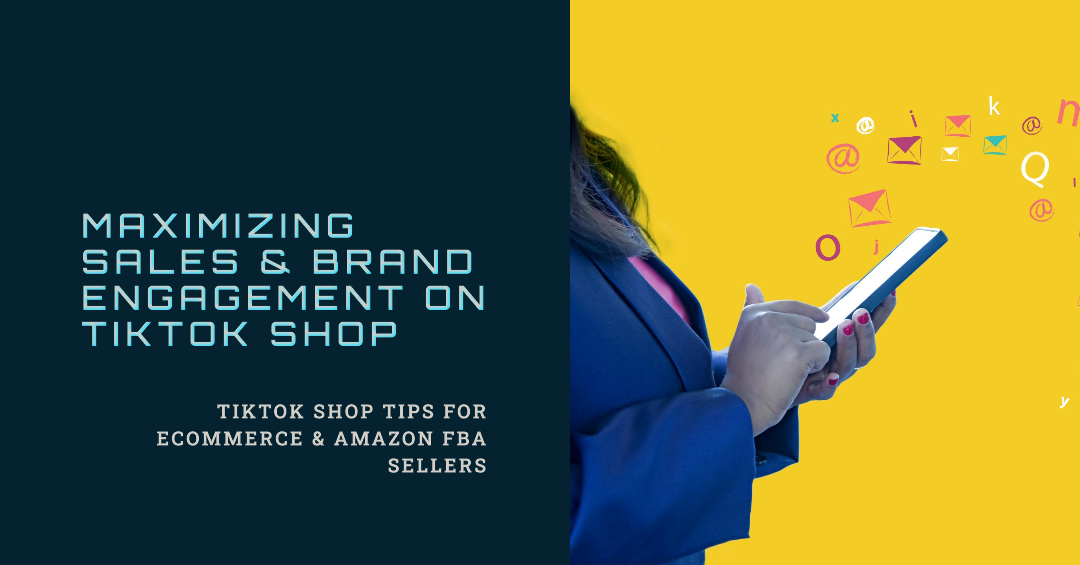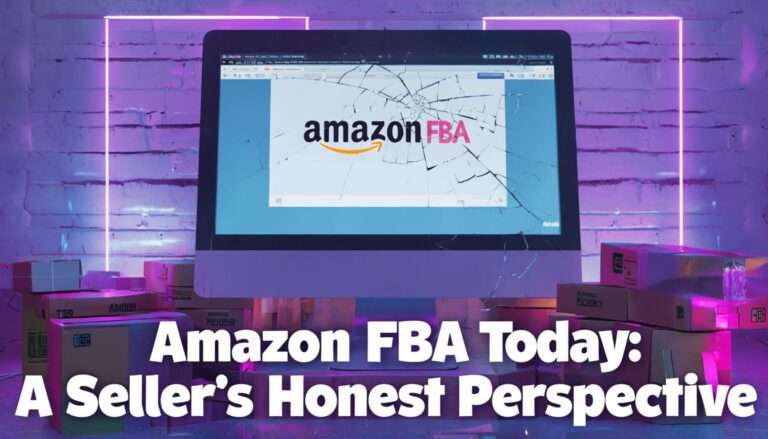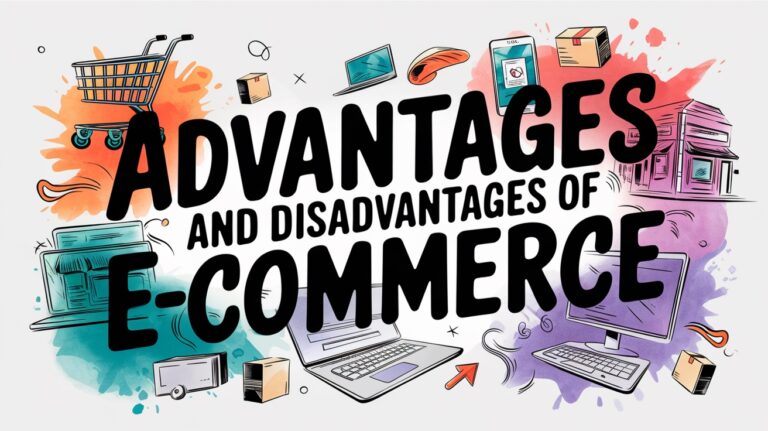E-commerce & Physical Product Brand Building: Beyond Just Selling
Think about the last product you bought because you trusted the brand. What was it that drew you in? Was it the packaging design, the quality, or perhaps, the consistency of the brand messaging? You see, building a physical product brand isn’t just about having a product to sell. It’s about carefully crafting an identity that resonates with your target audience, stands up to your competitors, and rides the wave of market trends. But how do you strike that balance and create a brand that not only draws in customers but keeps them coming back? Let’s explore this further.
Key Takeaways
Introduction
You’re not just selling a product, you’re building a brand. Recognize the importance of brand building in today’s cutthroat market.
A strong brand garners customer loyalty, enhances perceived value, and sets you apart from the competition.
I have fallen into the trap myself of selling just another product in the early days of selling on Amazon. It may work for a while but you quickly end up in a race to the bottom without the moat of a good brand that people love to follow and buy from.

Importance of building a brand in today’s competitive market
In today’s fiercely competitive market, building a robust brand isn’t just beneficial, it’s essential. The importance of your brand extends far beyond just a logo. It represents your company’s values, sets you apart from competitors, and builds customer loyalty. Here’s why:
- Differentiation: Your brand distinguishes you from your competitors. It’s what makes you unique and draws your target audience to you.
- Recognition: A strong brand is easily recognizable. Recognition equates to familiarity and trust.
- Customer loyalty: When customers connect emotionally with your brand, they become loyal advocates.
Don’t underestimate the power of a strong brand. It’s the foundation of your business and a key player in making it flourish.
Difference between selling a product and building a brand
While selling a product might get you quick sales, building a brand is what fosters customer loyalty and drives long-term growth. You see, selling a product is a one-time transaction. You’ve got an item, you exchange it for money, end of story.
But building a brand? That’s about creating a lasting relationship with your customers. It’s not just about what you’re selling, but who you’re as a company. It’s about your values, your story, and how you communicate with your audience.
Think of it like this: selling a product is a sprint, but building a brand is a marathon. It takes more effort, but the payoff is a stronger, more resilient business. So, don’t just sell products, build a brand.

Benefits of a strong brand (customer loyalty, perceived value, differentiation)
Building a strong brand doesn’t just look good on paper; it directly influences customer loyalty, perceived value, and sets your product apart from the competition.
- Customer loyalty: A strong brand creates an emotional connection with customers, making them more likely to stay loyal. They’ll keep coming back, knowing they can trust the quality and consistency of your product.
- Perceived value: When you’ve established a strong brand, customers see more value in your product. They’re not just buying a product; they’re buying into a brand they respect and admire.
- Differentiation: Your brand helps you stand out from the crowd. It’s more than a logo or tagline; it’s the identity that separates you from competitors, giving customers a compelling reason to choose your product.
Defining Your Brand Identity
It’s time to define your brand identity, an essential step in building your physical product brand.
You’ll need to clarify your core values, determine your target audience, and establish your brand’s voice and personality.
Core Values: Uncovering what your brand stands for.
Unearthing your brand’s core values is the initial essential step in defining its identity. These values are the backbone of your brand, guiding your decisions and shaping your brand’s culture.
Here’s a concise three-step guide to help you:
- Identify: Think about what matters most to you as a brand. What principles guide your operations? What’re you passionate about?
- Articulate: Once you’ve identified your values, express them clearly. Use words that resonate with your team and your audience.
- Incorporate: Values aren’t just words. They’re actions. Make sure your values are reflected in every aspect of your business, from product development to customer service.
Target Audience: Who are you trying to connect with?
After establishing your core values, the next important step in defining your brand identity involves understanding who exactly your target audience is. Who are you trying to connect with? It’s essential to know the demographics, psychographics, and behaviors of your potential customers. Are they millennials or baby boomers? Are they urban dwellers or rural residents? What’re their hobbies and interests?
The answers to these questions will help you tailor your products and marketing strategies to meet their specific needs and preferences. Remember, you can’t please everyone, so it’s better to focus on a specific group that aligns with your brand. This is the key to creating a brand that resonates and builds a strong connection with your target audience.
Brand Voice and Personality: How will you speak to your audience?
Having identified your target audience, defining your brand voice and personality becomes your next essential step; this is how you’ll engage and resonate with your customers. Your brand voice is the consistent communication style you’ll employ, while your brand personality is the character that makes your brand unique.
- Consistency: Whether it’s professional, casual, or humorous, maintain a consistent voice that reflects your product and audience.
- Authenticity: Be true to your brand. Don’t imitate others, your voice should be uniquely yours.
- Resonance: Your voice and personality should resonate with your audience, meeting their expectations and aligning with their values.
Developing a strong brand identity (logo, color scheme, voice, and messaging)
Building a rock-solid brand identity, which includes elements like your logo, color scheme, voice, and messaging, is essential in setting your physical product apart in a crowded marketplace. This identity becomes your product’s fingerprint, making it unmistakable and memorable.
Take time to create a compelling logo, it’s the face of your product. Choose a color scheme that resonates with your audience – colors invoke emotions and associations. Develop a consistent voice and messaging for your brand, it should align with your mission and values.
Here’s a simple table to guide you:
| Brand Element | Description | Example |
|---|---|---|
| Logo | Visual representation | Apple’s apple |
| Color Scheme | Colors that represent your brand | Coca-Cola’s red and white |
| Voice | Personality infused into communication | Innocent Drinks’ playful tone |
| Messaging | What and how you communicate | Nike’s empowering messages |

Building Brand Engagement
Now, let’s shift our focus to building brand engagement.
You’ll explore the importance of social media strategies and then we’ll look at ways to enhance engagement beyond social media.
These elements are vital to guarantee your brand doesn’t just exist, but thrives in the marketplace.
A. Social Media Strategies:
As you start developing your physical product brand, it’s essential to refine your social media strategies.
You’ll want to choose the best platforms for your target audience and create content that truly reflects your brand.
From incorporating interactive elements to cultivating a community, your social media efforts are vital in building brand engagement.
Choosing the right platforms for your target audience.
To effectively engage your target audience, selecting the right social media platforms that align with their habits and preferences is crucial. Follow these steps:
- Identify your audience’s preferred platforms.
- Research how your competitors use these platforms.
- Tailor your strategy to each platform’s unique features.
Creating engaging content (text, images, videos) that resonates with your brand.
After pinpointing your audience’s favorite social media platforms, it’s time to create compelling content that not only grabs their attention but also embodies your brand’s identity.
Develop carefully crafted posts with engaging texts, enchanting images, or entertaining videos that authentically represent your brand. Remember, consistency is key. Your content shouldn’t only speak to your audience but also reflect the core values and personality of your brand.
Building a community through interactive elements (polls, Q&A sessions).
Engage your audience by incorporating interactive elements such as polls and Q&A sessions into your social media strategy, fostering a sense of community around your brand. Here’s how:
- Polls: Create simple, quick-to-answer polls that spark curiosity and engagement.
- Q&A sessions: Schedule regular Q&A’s to address customer queries, showing you’re responsive and care.
- Community building: Encourage dialogue, discussions, and sharing within your community.
Creating engaging and shareable content (storytelling, behind-the-scenes, user-generated content)
Crafting engaging and shareable content is your brand’s secret weapon in the battle for customer attention on social media. Tell your brand’s story, show behind-the-scenes, and encourage user-generated content.
These strategies not only captivate your audience but also make them part of your brand journey. Remember, people love stories and feeling involved.
Building a community and fostering interaction
While engaging content paves the way for brand exposure, it’s equally important to focus on building a community and fostering interaction to truly make your brand come alive on social media.
- Start discussions to encourage responses.
- Respond promptly to comments, showing you value the interaction.
- Host virtual events or contests to stimulate engagement.
Influencer marketing and collaborations
To ramp up your brand’s visibility and engagement, consider diving into influencer marketing and collaborations on social media platforms. Not only does this strategy expose your brand to a wider audience, but it also builds trust and authenticity. Here’s a simple guide:
| Step | Action | Benefit |
|---|---|---|
| 1 | Identify suitable influencers | Expands reach |
| 2 | Plan your collaboration | Establishes goals |
| 3 | Execute the collaboration | Increases visibility |
| 4 | Monitor performance | Assesses effectiveness |
| 5 | Adjust strategy as needed | Promotes growth |
Remember to keep it genuine and reciprocal!
Social media advertising and targeted campaigns
Utilizing the power of social media advertising and targeted campaigns can greatly enhance your brand’s engagement and reach. Consider these three steps:
- Tailor ads to your target audience’s interests.
- Use analytics to refine your campaigns.
- Engage your audience with interactive content.
Done right, these strategies can bring your brand closer to its audience, creating memorable experiences that boost your bottom line.
B. Beyond Social Media:
You’ve already tapped into social media, but your brand engagement doesn’t have to stop there.
Think about content marketing, such as blog posts or videos that showcase your expertise.
Consider collaborations with other brands or influencers, host events to connect with customers in person, and don’t forget about the power of a robust email list.
Content Marketing: Blog posts, articles, or video series that showcase your expertise.
In the domain of content marketing, creating engaging blog posts, articles, or video series can effectively showcase your expertise and boost your brand’s engagement. To achieve this:
- Make your content informative and practical.
- Use a consistent tone that aligns with your brand’s image.
- Regularly update your content to keep your audience engaged and coming back for more.
Collaborations: Partnering with other brands or influencers to reach new audiences.
While regularly updating your content helps retain your existing audience, collaborations can open doors to new audiences, strengthening your brand’s reach and engagement.
Partnering with other brands or influencers not only grows your visibility but also enhances credibility. You’ll reach new demographics, gain access to fresh perspectives, and create exciting content.
Events and Experiences: Creating opportunities to connect with customers in person.
Beyond the digital world, hosting events and experiences offers a unique opportunity to build a stronger connection with your customers in person. Here’s how:
- Product Launches: Showcase your latest product in an exciting way.
- Workshops: Engage customers by teaching them something new.
- Pop-up stores: Create a unique, immersive shopping experience.
Building an email list and nurturing relationships
To build deeper engagement with your customers, start by creating a robust email list and nurturing those relationships consistently.
It’s not just about gathering emails – it’s about establishing trust and communication.
Send out regular newsletters, share exclusive deals, or offer valuable content.
Remember, every email is a chance to reinforce your brand’s value and keep your customers connected to your story.
Be regular, be relevant, and be respectful.

Leveraging Marketplaces and Diversifying Channels
You can exponentially increase your physical product’s visibility by selling on popular online marketplaces such as Amazon, Etsy, TikTok, and eBay.
It’s also beneficial to establish your own e-commerce website, giving you full control over your brand and access to valuable customer data.
Don’t forget to diversify your sales channels using methods like pop-up shops, brick-and-mortar stores, wholesalers, and even affiliate marketing partnerships.
Selling on popular online marketplaces (Amazon, Etsy, TikTok, eBay) As well as niche marketplaces
Expanding your brand’s presence across popular online marketplaces like Amazon, Etsy, TikTok, and eBay, as well as niche marketplaces, can greatly amplify your product’s visibility and potential customer reach.
- Amazon and eBay: These platforms have massive user bases. Listing your product here can expose your brand to millions of potential customers worldwide.
- Etsy and TikTok: If your product aligns with the creative, handmade, or trend-focused demographics of these sites, you could tap into dedicated, engaged communities.
- Niche Marketplaces: Don’t overlook these specialized platforms. They cater to specific interests, making it easier for you to reach your target audience.
Building your own e-commerce website for brand control and customer data.
When leveraging the power of popular and niche marketplaces, it is crucial to consider creating your own e-commerce website for direct control over your brand and access to invaluable customer data. Building your own site gives you the freedom to create a unique brand experience, showcase your products exactly as you wish, and interact directly with your customers.
Here’s a quick comparison of the advantages:
| Marketplaces | Your Own Website |
|---|---|
| Access to large customer base | Brand control |
| Easy setup | Customer data access |
| Existing trust & security | Personalized customer experience |
| Less marketing required | SEO control |
| Fixed structure | Creative freedom |
Diversifying sales channels (eCommerce website, pop-up shops, brick-and-mortar, wholesalers)
Constructing an e-commerce website provides control and data access, but it’s equally important to explore other sales channels to effectively reach different customer groups.
- Consider pop-up shops. They’re a great way to test market interest and engage with consumers face-to-face. You’ll get valuable feedback and build brand awareness.
- Think about brick-and-mortar stores. They might seem old-fashioned, but many consumers still enjoy the tactile shopping experience. Plus, they offer a chance to showcase your brand’s personality in a physical space.
- Don’t neglect wholesalers. If you’ve got a product that can be sold in bulk, this channel can massively increase your reach and revenue.
Leveraging affiliate marketing and partnerships
Diving into the world of affiliate marketing and partnerships can turbocharge your brand’s visibility and sales, provided you navigate this space with a well-crafted strategy. Start by identifying influencers or bloggers within your niche who’ve a sizable, engaged audience. You’re not just looking for numbers, you want potential partners whose audience aligns with your target demographic.
Then, approach these potential partners with a mutually beneficial proposal. Maybe it’s a commission on each sale, or a flat fee for a product review. The key is to create a win-win situation: they get rewarded for their influence, and you get access to their audience. Remember, the right partnership can give your brand a significant boost, so choose wisely.
Building a brand is an ongoing journey, not a destination.
You’re not just establishing a brand; you’re setting out on a journey. This journey requires you to define key performance indicators, track metrics like website traffic and sales, and adapt your strategies based on these metrics and customer feedback.
Defining key performance indicators (KPIs) for brand building
Often, it’s essential to define clear key performance indicators (KPIs) that can effectively track your brand-building progress. Here’s how to define them:
- Identify Your Goals: What do you want to achieve with your brand? Sales increase, customer loyalty, or market share growth? Your KPIs should align with these goals.
- Determine Key Metrics: Choose measurable indicators that reflect your goals. For instance, customer retention rate can be a KPI if your goal is customer loyalty.
- Set Benchmarks: Establish a current level for each KPI to track improvements.
Tracking and analyzing metrics (website traffic, engagement, sales, brand sentiment)
In the course of building your brand, it’s crucial to consistently monitor and analyze key metrics such as website traffic, engagement, sales, and brand sentiment. These figures are the pulse of your brand, telling you how well it’s resonating with your target audience.
Analyzing website traffic, you’ll identify which pages are performing well and where users are dropping off. Engagement metrics reveal how your audience interacts with your content, while sales metrics give insight into the financial health of your brand. Finally, tracking brand sentiment can provide a glimpse into how consumers perceive your brand.
Adapting strategies based on data and customer feedback
After evaluating these key metrics and understanding your brand’s current standing, it’s time to adapt and refine your strategies using the data and customer feedback you’ve gathered.
Consider these steps:
- Interpret the Data: Go beyond the numbers, look for patterns and trends that could influence your strategy.
- Listen to Your Customers: They’re the ones using your product. If they’ve suggestions or complaints, take them seriously. They can offer invaluable insights for improvement.
- Be Flexible: Don’t be afraid to make changes if something isn’t working. Adaptability is key in a dynamic market.
Continuously refining and evolving the brand
Remember, building a brand is much like starting on a never-ending journey, not a one-time destination – it demands continuous refinement and evolution.
You’ve got to keep your finger on the pulse of your market, adapting to shifting trends and customer needs. Don’t be afraid to tweak your branding to reflect these changes. It’s not about abandoning your core identity, but about keeping it relevant and vibrant.
Understand that refinement and evolution aren’t signs of inconsistency but of growth. So, keep your eyes open, always be ready to learn and improve. And most importantly, don’t get complacent.
You’re never done building your brand because the marketplace is always changing, and so should you.

Use an holistic approach To Boost Sales & Awareness
Taking an holistic approach to building your physical product brand in terms of platforms, marketplaces and engagement can yield great results. Consider using platforms like TikTok Shop, where affiliates and creators can generate engaging videos to showcase your product.
Then, direct that TikTok traffic to other platforms, such as Amazon, to give your brand a significant boost.
You can list your Amazon products on Tiktok shop taking advantage of the traffic and engagement and pay creators to showcase it selling it directly on their profile. You then simply fulfil it from Amazon or even now using Fulfilment by TikTok
Use TikTok Shop and get affiliates/creators to make engaging videos
Leveraging the power of TikTok Shop, you can collaborate with influencers and creators to produce engaging videos that showcase your physical product in a dynamic and appealing way. You can find the best creators and don’t need to get in front of a camera yourself. This strategy not only amplifies your brand reach but also boosts product interest and potential sales.
Here’s a three-step guide:
- Identify: Find creators whose audience aligns with your target market. They’re your best bet for genuine promotion.
- Collaborate: Work closely with them to create compelling content that highlights your product’s unique value.
- Promote: Encourage the creator to share the video on their TikTok and other social platforms.
Send that tiktok traffic to other platforms like amazon to boost those platforms
Once you’ve established a strong presence on TikTok, it’s time to strategize on directing that traffic to other platforms like Amazon, thereby maximizing your brand’s visibility and sales.
You can leverage your TikTok followers by sharing exclusive deals, launches, or sneak peeks of your products on Amazon. Use your TikTok profile to share Amazon product links, and encourage your audience to check them out.
Frequently Asked Questions
What Are Some Cost-Effective Strategies for Building a Physical Product Brand?
You’re asking about budget-friendly strategies to build a brand. Utilize social media for marketing, engage with your audience, create a unique logo, and offer high-quality products. Remember, consistency is key in brand-building.
How Does Customer Feedback Influence Product Brand Building?
Like a compass guiding a ship, customer feedback steers your brand building. It shows what’s working and what’s not, helping you refine your product and strengthen your brand’s identity. It’s priceless in shaping your brand’s journey.
What Role Does Packaging Design Play in Establishing a Physical Product Brand?
Packaging design is essential for you. It’s your product’s first impression, influencing perceptions and buying decisions. It’s not just a container, it’s a communication tool, delivering your brand’s story, setting you apart from competition.
How Can I Measure the Success of My Physical Product Brand Building Initiatives?
You can measure your brand building success by tracking sales growth, customer loyalty, and brand recognition. Monitor customer feedback and social media engagement. Your product’s market position and overall reputation also indicate brand building effectiveness.
Are There Specific Pitfalls or Common Mistakes to Avoid in Physical Product Brand Building?
Yes, avoid neglecting consumer feedback and market research. Don’t undervalue product quality, as it’s the heart of your brand. Also, don’t rush branding; it’s a journey, not a sprint. Your brand’s authenticity matters most.
Conclusion
To sum up, establishing a physical product brand requires consistent effort and strategic planning. It’s worth mentioning that according to Forbes, 64% of consumers cite shared values as the primary reason they’ve a relationship with a brand.
So, always keep your brand values at the forefront, and remember it’s a continuous journey, not a destination. Utilize an all-inclusive approach, leverage marketplaces, and diversify channels for a truly robust brand.

